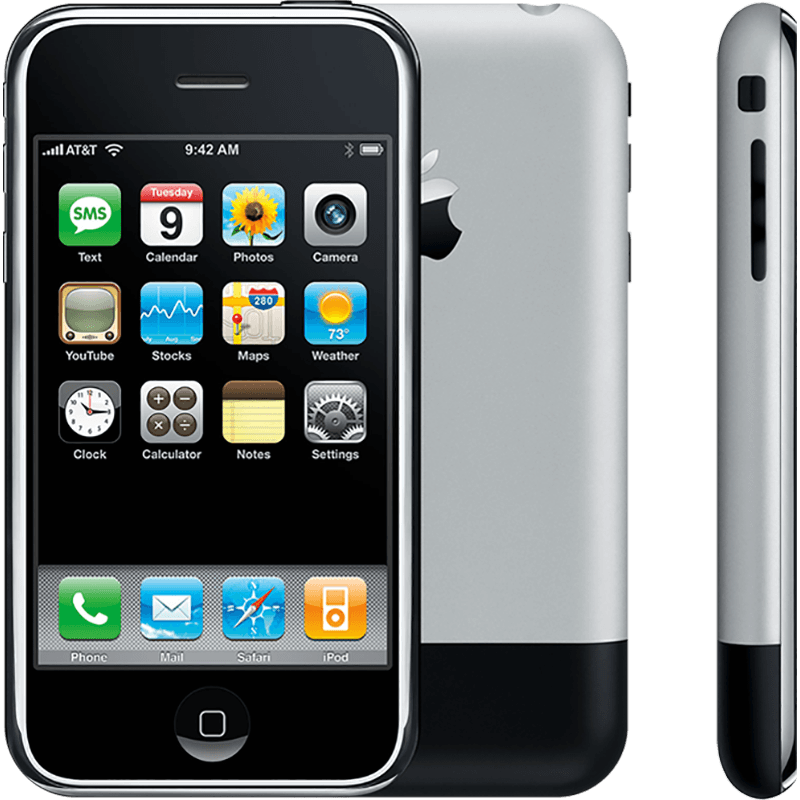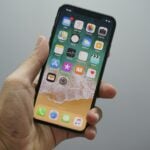The iPhone (1st gen) revolutionized the smartphone industry when Apple unveiled it in 2007. This groundbreaking device combined a mobile phone, iPod, and internet communicator into one sleek package. The original iPhone featured a 3.5-inch touchscreen display, 4GB or 8GB of storage, and ran on the innovative iPhone OS.
Steve Jobs introduced the iPhone at Macworld Expo, showcasing its unique features like multi-touch gestures and visual voicemail. The device’s specifications were impressive for its time, including a 2-megapixel camera, Wi-Fi connectivity, and Bluetooth support. Apple’s attention to detail was evident in the iPhone’s design, with its aluminum and plastic body measuring just 11.6mm thick.
The iPhone’s impact on mobile computing cannot be overstated. Its App Store, launched in 2008, created a new ecosystem for mobile applications. While some criticized its lack of 3G connectivity and physical keyboard, the iPhone’s intuitive interface and web browsing capabilities set a new standard for smartphones.
| Feature | Specification |
|---|---|
| Display | 3.5-inch touchscreen |
| Storage | 4GB or 8GB |
| Camera | 2-megapixel |
| OS | iPhone OS 1.0 |
| Processor | 412 MHz ARM 11 |
| RAM | 128MB |
The first-generation iPhone, also known as the iPhone 1 or iPhone 2G, was a revolutionary device when it was released in 2007. Here are some of its key specifications:
Display:
- 3.5-inch diagonal LCD screen
- 320 x 480 pixel resolution at 163 ppi
- 3:2 aspect ratio
- 18-bit (262,144 colors)
Camera:
- 2.0 MP rear camera with geotagging (not GPS-based)
Storage:
- 4 GB, 8 GB, or 16 GB flash memory
Memory:
- 128 MB eDRAM
Processor:
- Samsung 32-bit ARM microprocessor (underclocked to 412 MHz)
Operating System:
- Original: iPhone OS 1.0
- Last: iPhone OS 3.1.3
Connectivity:
- Quad-band GSM/GPRS/EDGE (850, 900, 1800, 1900 MHz)
- Wi-Fi (802.11 b/g)
- Bluetooth 2.0
- USB 2.0/proprietary 30-pin dock connector
Battery:
- 3.7 V 1400 mAh Lithium-ion battery
Other Features:
- Multi-touch touchscreen display
- 3-axis accelerometer
- Proximity sensor
- Ambient light sensor
- Single loudspeaker
- TRRS headphone jack
- Microphone
Physical Attributes:
- Dimensions: 4.5 x 2.4 x 0.46 inches (115 x 61 x 11.6 mm)
- Weight: 4.76 oz (135 g)
Key Innovations:
- Multi-touch touchscreen interface
- Visual Voicemail
- Safari web browser
- HTML email
- “iPod” music and video player app
It’s important to remember that the first-generation iPhone lacked many features that we now consider standard in smartphones, such as an App Store, MMS messaging, and copy and paste functionality. However, it was a groundbreaking device that paved the way for the modern smartphone era.
Design and Build
The first-generation iPhone introduced a groundbreaking design that set the standard for future smartphones. Its sleek form factor and innovative touchscreen interface marked a departure from traditional mobile phones of the time.
Dimensions and Weight
The original iPhone measured 115 mm (4.5 inches) in height, 61 mm (2.4 inches) in width, and 11.6 mm (0.46 inches) in depth. It weighed 135 grams (4.8 ounces), making it relatively lightweight for its size.
This compact design allowed for easy one-handed use. The 3.5-inch display dominated the front of the device. A single home button below the screen provided quick access to the main menu.
| Dimension | Measurement |
|---|---|
| Height | 115 mm |
| Width | 61 mm |
| Depth | 11.6 mm |
| Weight | 135 grams |
Materials and Colors
Apple chose premium materials for the iPhone’s construction. The front featured a scratch-resistant glass screen. A brushed aluminum back panel gave the device a sophisticated look and feel.
The original iPhone came in a single color option: silver and black. This minimalist color scheme highlighted its elegant design. The aluminum casing provided durability while keeping the device lightweight.
The combination of glass and metal created a premium feel. This set the iPhone apart from plastic-bodied phones common at the time. The design’s simplicity became an iconic look for future iPhone models.
Hardware Components
The first-generation iPhone packed innovative hardware into a sleek, compact design. Its components set new standards for smartphones, combining a touchscreen display, powerful processor, and various sensors.
Display
The iPhone featured a 3.5-inch LCD touchscreen with a resolution of 320×480 pixels. This display offered 163 pixels per inch, providing crisp visuals for its time. The screen used capacitive touch technology, allowing for more precise input than resistive touchscreens common in other devices.
Apple coated the display with scratch-resistant glass. This protective layer helped maintain the screen’s clarity and responsiveness over time. The display supported multi-touch gestures, enabling pinch-to-zoom and other intuitive controls.
Processor and Memory
At the heart of the iPhone was the Samsung 32-bit ARM processor, specifically the S5L8900. This chip ran at 412 MHz, balancing performance with power efficiency. The device came with 128MB of RAM, which was substantial for mobile devices of that era.
Storage options included 4GB, 8GB, and later 16GB models. This solid-state storage provided quick access to apps and media. The lack of expandable storage encouraged users to rely on cloud services and careful data management.
Battery and Charging
The iPhone used a built-in rechargeable lithium-ion battery. It offered up to 8 hours of talk time on 2G networks or 6 hours of internet use. Standby time reached up to 250 hours.
Charging occurred through the 30-pin dock connector at the bottom of the device. This port also served for data transfer, supporting USB 2.0 speeds. The original iPhone did not support wireless charging, a feature that would come in later models.
Audio and Sensors
Audio capabilities included a built-in speaker and microphone. The 3.5mm headphone jack allowed for personal listening. Call quality was enhanced by noise cancellation technology.
The iPhone incorporated several sensors:
- Proximity sensor: Detected when the phone was near your face
- Ambient light sensor: Adjusted screen brightness
- Accelerometer: Enabled screen rotation and motion-based controls
These sensors improved user experience and battery life. They allowed the iPhone to respond intelligently to its environment and usage patterns.
| Component | Specification |
|---|---|
| Display | 3.5″ LCD, 320×480 pixels, 163 PPI |
| Processor | Samsung S5L8900, 412 MHz |
| Memory | 128MB RAM |
| Storage | 4GB, 8GB, or 16GB |
| Battery | Lithium-ion, up to 8 hours talk time |
| Ports | 30-pin dock connector, 3.5mm audio jack |
| Sensors | Proximity, ambient light, accelerometer |
Connectivity and Network
The first-generation iPhone combined advanced wireless technologies with cellular network capabilities. This revolutionary device offered users multiple ways to stay connected.
Wireless Technologies
The original iPhone featured Wi-Fi connectivity for high-speed internet access. This allowed you to browse the web, check email, and use internet-based apps when in range of a wireless network.
Bluetooth 2.0 was also included, enabling wireless connections to accessories like headsets and car audio systems. This technology made it easy to use hands-free calling or listen to music wirelessly.
Cellular Network
The iPhone supported quad-band GSM for global cellular connectivity. This meant you could use your iPhone in many countries around the world.
For data, the device utilized EDGE (Enhanced Data rates for GSM Evolution) technology. While slower than 3G, EDGE provided internet access when Wi-Fi wasn’t available.
| Network Type | Technology |
|---|---|
| Cellular | Quad-band GSM |
| Data | EDGE |
| Wireless | Wi-Fi, Bluetooth 2.0 |
The iPhone required a SIM card for cellular service. This small chip stored your phone number and carrier information.
Software and Features
The first-generation iPhone introduced a revolutionary operating system and unique applications. Its software laid the foundation for future iOS devices and changed how users interact with smartphones.
Operating System
The original iPhone ran iPhone OS, later renamed iOS. This touchscreen-optimized system offered an intuitive interface with icon-based navigation. Users could swipe, tap, and pinch to control the device.
Key features included:
- Home screen with app icons
- Multi-touch gestures
- Visual Voicemail
- Safari web browser
- Google Maps integration
The OS supported software updates, with the final version being iPhone OS 3.1.3. These updates added features and improved performance over time.
Applications and Services
Pre-installed apps on the first iPhone included:
| Application | Function |
|---|---|
| Phone | Calls and contacts |
| Email client | |
| Safari | Web browsing |
| iPod | Music and video playback |
| Calendar | Scheduling |
| Photos | Image viewing |
| Notes | Text notes |
The device lacked an App Store at launch. Users relied on web apps for additional functionality. Apple later introduced the SDK and App Store, allowing third-party developers to create native applications.
iTunes integration enabled content syncing and device management. The iPhone functioned as a widescreen iPod, offering a familiar media experience for existing iPod users.
Frequently Asked Questions
The original iPhone revolutionized the smartphone industry with its innovative features and design. Many people still have questions about this groundbreaking device.
What were the original iPhone’s technical specifications?
The first iPhone had a 3.5-inch touchscreen display with 320×480 pixel resolution. It featured a 3.2-megapixel camera and 4GB or 8GB of storage. The device ran on a 412 MHz ARM 11 processor with 128MB of RAM.
How much did the first iPhone cost at launch?
Apple priced the original iPhone at $499 for the 4GB model and $599 for the 8GB version. These prices were with a two-year contract from AT&T, the exclusive carrier at launch.
What features set the first iPhone apart from other smartphones at the time?
The iPhone’s multi-touch interface was revolutionary. It also combined a phone, iPod, and internet device in one sleek package. The full web browser and visual voicemail were unique features at the time.
Can the first-generation iPhone still operate on current networks?
No, the original iPhone cannot connect to modern cellular networks. It only supported 2G networks, which have been phased out by most carriers. Wi-Fi connectivity may still work on some networks.
What was the official name of Apple’s first iPhone model?
Apple simply called it “iPhone” at launch. It later became known as the iPhone 2G or iPhone 1 to distinguish it from later models. Some refer to it as the “original iPhone” or “first-generation iPhone.”
Is there still support for the iPhone SE 1st generation by Apple?
Apple no longer provides software updates for the iPhone SE 1st generation. The device received its last iOS update in 2019 with iOS 13. However, you may still find some third-party app support and accessories.
| Feature | Specification |
|---|---|
| Display | 3.5-inch touchscreen |
| Resolution | 320×480 pixels |
| Storage | 4GB or 8GB |
| Camera | 2.0 megapixels |
| Processor | 412 MHz ARM 11 |
| RAM | 128MB |
| Network | 2G (GSM/EDGE) |







